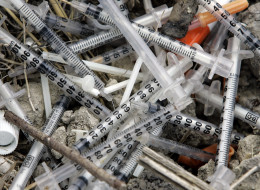PORT ANGELES — Health officials hope you’ll drop a dime on that syringe you see lying on the ground.
They want you to report it and its location, of course, not to throw away small change.
Christina Hurst, public health programs manager for Clallam County Health and Human Services, wants to clean up Port Angeles and environs of syringes used for illegal drugs and to educate drug users about how to dispose of syringes safely.
With help from the Port Angeles Citizen Action Network — PA CAN, an offshoot of Revitalize Port Angeles — Hurst wants to track where people are discarding their needles in public.
They should call her at 360-417-2364 to report a syringe and its location and learn how to dispose of it harmlessly — usually by placing it carefully into a plastic beverage bottle and discarding it in the trash.
Or, she said, they can bring syringes they find to the Health and Human Services clinic at 111 E. Third St., from where the department runs its Syringe Services program in which drug users can exchange used needles for new ones, reducing the danger of communicable disease and disposing of them safely.
Meanwhile, PA CAN, Health and Human Services and the North Olympic Salmon Coalition will clean up syringes and other trash along Peabody Creek on Saturday.
Participants will meet at 9 a.m. at Olympic Powersports, 221-A S. Peabody St., “to make the creek more of an inviting place. Call Hurst for details.
“We all want solutions to this problem,” Hurst told members of the Clallam County Board of Health on Tuesday.
“I think we can. The area that is lacking is hard-core information.”
Hurst said PA CAN and her department would launch a public information campaign in about two weeks. Meanwhile, she is sticking pins into a map to mark where discarded syringes are found.
Hurst said it was an urban myth that lots of syringes are “everywhere.”
She said that about 200 of them had been found over the last couple of months — 150 of them in a single spot she called “a little dumpsite that was accidental and that involved law enforcement,” without giving more details.
Nonetheless, she said, “I anticipate this being an ongoing project to really effect some change.”
In the meantime, county health authorities continue to distribute naloxone kits at their Syringe Services program.
Naloxone if administered in time can counter an overdose of heroin or other opiate drug, although the patient still must get immediate medical attention.
Despite a surge in heroin deaths, however, few hard statistics are available about total overdoses, said Dr. Jeannette Stehr-Green, interim Clallam County health officer from Feb. 13 through Aug. 31, when she was replaced by Dr. Christopher Frank.
During the reporting period of 2012 through 2014, the state’s rate of deaths from opiate drugs was 8.4 per 100,000 in population. Jefferson County’s death rate was 9.7 per 100,000, while Clallam’s was 13.4.
Currently, county health officials must rely on death certificates and hospitalization records to track overdoses.
“It’s kind of a difficult thing to do, to determine whether making naloxone available made a difference to opiate users and their families,” Stehr-Green said.
Therefore, she has asked the board of health — to which she has been reappointed — to declare every drug overdose — fatal or nonfatal — a “notifiable disease” that requires health providers and first responders to report to Health and Human Services.
Overdoses would join other reported ailments that include chlamydia, giardiasis, gonorrhea, hepatitis C, measles, pertussis, salmonella and syphilis.
The Clallam County coroner, as well as Olympic Medical Center, Forks Community Hospital, first responders and private providers all would report overdoses to health authorities within 24 hours.
Making drug overdose a notifiable disease is within the authority of the county health officer, Stehr-Green said, but she preferred that the board of health concur and approve it at their Nov. 19 meeting.
Clallam would become the first county in Washington state to do so. Only the states of New Mexico and Texas make drug overdose a notifiable disease, she said.
Since Clallam County began distributing naloxone in its Syringe Services program, it has learned of five opiate overdoses in which four of the people survived, Stehr-Green said.
The purpose of making it a notifiable disease, she said, “Is to determine what happened, how it could have been prevented and if we can get them into some kind of treatment.
“It would provide us information to enable us to evaluate our naloxone program. We want to collect data so we can do something about the problem.”
_______
Reporter James Casey can be reached at 360-452-2345, ext. 5074, or at jcasey@peninsuladailynews.com.

